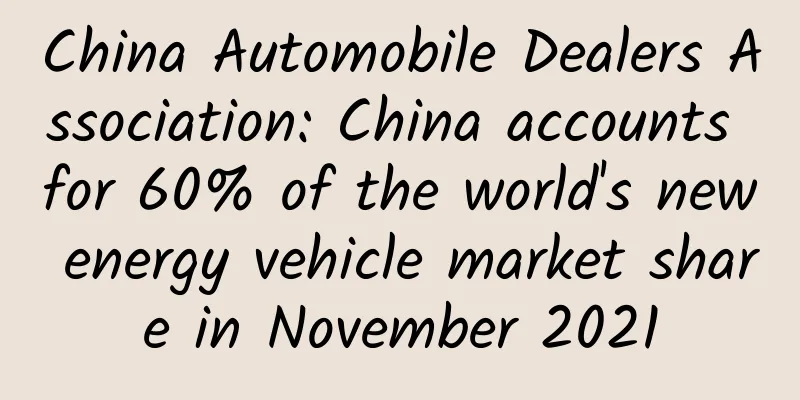China Automobile Dealers Association: China accounts for 60% of the world's new energy vehicle market share in November 2021

|
From January to November 2021, global sales of new energy passenger vehicles in a broad sense reached 7.96 million units, of which plug-in hybrid, pure electric, and fuel cell new energy vehicles sold 5.25 million units globally, a year-on-year increase of 124%. China's new energy passenger vehicles accounted for 51% of the world's total in 2019, but in 2020, affected by the policy environment and the epidemic, China's position in the new energy vehicle market fell to 41%, with Europe's overtaking trend evident. From January to November 2021, China's new energy passenger vehicles accounted for 52% of the world's total, of which 60% in November accounted for 60% of the world's total new energy, an excellent performance. The reason for the strong performance of new energy vehicle sales in 2020 was the pressure of carbon emissions, not the significant contribution of Tesla. Under the influence of the overseas epidemic, the European and American markets have strong support for new energy policies. The Chinese new energy vehicle market gradually recovered in the second half of 2020. In 2021, China accounted for 51% of the world's new energy vehicles. Due to the sluggish market in Europe under the epidemic, China's world position returned to a high level of 60% in November. China's drive for global growth is mainly due to the shift of China's new energy vehicle market to market-oriented promotion, forming a strong endogenous growth momentum. The commercial vehicle market analysis is specifically mentioned here, mainly because the world's new energy trucks and buses are basically in China, and new energy buses are in decline after the epidemic. Although China's share has increased a little, the analysis is not very meaningful. 1. Global new energy vehicle trends From the broad sense of new energy vehicles, return to the narrow sense of new energy passenger vehicles analysis context: The development of new energy vehicles in the world started with hybrid power, and then gradually entered the battery-based era. Pure electric and plug-in hybrid vehicles became the real policy support for new energy. The development of new energy vehicles in China also started with subsidies for ordinary hybrid buses and trucks. Later, buses entered the pure electric era, and hybrid buses became history. In this analysis, we do not consider buses and special-purpose vehicles, but only passenger cars. The reason is that the technology of buses and special-purpose vehicles is relatively backward, and there is no market space outside of policies for buses, road right vehicles, etc. in the near future. Therefore, all countries have made passenger cars the focus of new energy development. 1. Trends of the global broad new energy passenger vehicle market from 2004 to 2020 In 2012, the world had 1.58 million new energy passenger vehicles, but by 2015, it had only 1.79 million, with slow growth. With the accelerated development of new energy vehicles starting in 2016, the number of new energy vehicles in a broad sense exceeded 2 million in 2016, reached 3.17 million in 2017, exceeded 4 million in 2018, and reached 5.15 million in 2020. From January to November 2021, there were 8.04 million new energy vehicles in a broad sense, of which ordinary hybrid vehicles accounted for 35%. From 2018 to 2021, the proportion of hybrid vehicles continued to decline to 35%, and gradually achieved a stable share. Among them, hybrid passenger cars gradually declined from 93% in 2012 to 79% in 2015, and then the proportion of hybrid vehicles decreased by 10 percentage points each year. In 2019, the decline in hybrid market share slowed down, but in 2021, the share still fell to 35%. In 2021, the trend of plug-in hybrid vehicles was strong, the performance of hybrid vehicles gradually weakened, and pure electric vehicles were relatively stable. 2. Global performance of new energy passenger vehicles in 2021
3. Global new energy passenger vehicle market trends from 2016 to 2020 In the first half of 2020, the world's new energy vehicles faced high base pressure, and entered a low base stage in July, laying the foundation for a new new energy growth cycle. From January to November 2021, the upward trend accelerated. Due to the severe epidemic in Europe last year, the growth was stronger under the low base. Sales of new energy vehicles in 2020 reached 2.85 million units, a year-on-year increase of 35%. The deceleration trend in recent years has exceeded expectations. In 2019, the sales volume of new energy vehicles reached 2.11 million units, a strong year-on-year growth of 7%. In the previous few consecutive years, the global new energy sales volume has exceeded the growth rate of 60%. In 2021, the performance was strong, and the growth rate from January to November rebounded to 124%. Judging from the regional market trends of new energy vehicles, Europe has been accelerating upward in 2020, and the overall European new energy vehicle market will be stable at a high level in 2021; while the Chinese new energy vehicle market continued to be strong in 2021, with continued acceleration from August to November; the US market for new energy vehicles is relatively sluggish and stable. The trend of China's new energy vehicle market, which has grown rapidly from a weak position, is relatively different from that of traditional vehicles, especially the fluctuation between the year and the month, which is not only affected by consumption, but also by policies and other environments. Therefore, the market changes of new energy vehicles should be more complicated. However, with the overall trend of new energy vehicle market transformation, new energy vehicles have gradually turned to a regular operation state in the near future. In 2021, the sales of new energy vehicles will start high, and Europe's November performance was better than expected, and continued to develop well. 4. New energy penetration rate in various countries around the world The penetration rate of new energy vehicles in the world is generally showing a rapid upward trend, reaching 7% this year, of which China's new energy penetration rate is 12%; Germany's is 22%; Norway's is 69%; the United States is only 4%; Japan's is only 0.8%; therefore, the imbalance of new energy development in the world is extremely obvious. As the United States increases the penetration of new energy, new energy vehicles in the world have entered a new stage of strong development. 2. Global new energy vehicle structure market trends 1. Global new energy passenger vehicle market trends from 2015 to 2021 The European new energy market in January-November 2021 was affected by the epidemic, and its share dropped significantly compared with 2020. The recent growth rate of China's new energy passenger vehicles is weaker than the world's average growth rate. In 2020, China's new energy passenger vehicle world share reversed significantly, with a sluggish first quarter, a reversal in the second quarter, and a surge in the second half of the year. It remained strong from January to November 2021, with a share of 53% in November. Sales in other countries outside China are strong and volatile. At the end of 2020, the average growth rates of France and Germany were between doubled, and Europe was relatively strong. The slower growth rate was in Japan, which was relatively low, and the growth rate of new energy markets such as South Korea was also average. 2. Product structure of new energy passenger vehicles worldwide The proportion of pure electric vehicles has increased in recent years, reaching 72% this year, and the hydrogen energy market is seriously underdeveloped; the share of plug-in hybrid vehicles has declined, and a pattern similar to that of traditional vehicles has gradually emerged. 3. Structure of new energy passenger vehicles worldwide – Q4 2021 In the fourth quarter of 2021, the global new energy vehicle structure is that the European market is stronger, followed by Asia, so the European market structure has a clear feature of being equal between pure electric and plug-in hybrid. France and Norway have a high proportion of pure electric. China's recent structural upgrade has driven the improvement of the world's vehicle structure. The share of China's A00-class pure electric vehicles has dropped to 35% of China's new energy vehicles, and the share of A-class vehicles has increased to 24%, resulting in a significant increase in the share of A-class vehicles in the world's structure. 4. Analysis of the trend structure of major countries In the broad sense of new cars, about 70% of the Chinese market is pure electric, 15% is plug-in hybrid, and 15% is hybrid. 15% of the Chinese market is hybrid, while Germany's hybrid accounts for 10%, the United States' hybrid power accounts for 56%, plug-in hybrid accounts for only 12%, and pure electric accounts for only 32%. Therefore, in the broad sense of new energy vehicles, the United States' hybrid performance is relatively strong, pure electric performance is relatively strong, plug-in hybrid is relatively low in the US market, lower than pure electric performance, while Europe's plug-in hybrid and pure electric have similar proportions. So overall, the Chinese market is dominated by pure electric vehicles, while the US market is relatively strong in hybrid vehicles, and the German market is relatively strong in plug-in hybrid vehicles. The three form a sharp contrast. In the pure electric vehicle market, China's B-class cars account for 30%, the United States accounts for 69%, Germany accounts for 21%, and Germany has a stronger share of A00 and A0 classes, accounting for 51%; China's A00 and A0 classes are at the level of 45%; the United States' A00 and A0 classes are at the level of nearly 20%. So overall, the new energy vehicles in the Chinese market are relatively high-end, the United States is super high-end, and Germany is super micro-car. 3. Global new energy vehicle structure market trends 1. Market share trends of various types of new energy vehicles – obvious differences There are obvious differences in new energy vehicles among manufacturers around the world. Toyota's hybrid power is super powerful, while Tesla only has pure electric power and occupies an absolute dominant position. European Volkswagen and BMW's plug-in hybrid vehicles performed strongly. 2. Trends in new energy vehicle market share of various manufacturers Tesla remains the world's number one and is currently going strong. China's SAIC Motor's new energy vehicle performance is excellent, and SAIC Passenger Vehicle and SAIC-MW have performed very well. Germany's Volkswagen's new energy vehicle performance is relatively strong, but this year it was severely affected by the epidemic, and coupled with the sprint at the end of last year, the trend was weak at the beginning of the year. BMW Group, BYD, Germany's Mercedes-Benz, etc. remain at the second echelon level. Competition in the new energy wave of luxury cars is relatively fierce. Tesla in the United States has performed extremely well, pushing Mercedes-Benz and BMW to increase their investment in new energy vehicles. At present, the improvement speed of BMW and Mercedes-Benz's performance cars is not very fast. Tesla's sales are currently the increase of model3 and modelY. In recent years, the models of Chinese new energy vehicle companies have performed very well, especially the pure electric models in 2021, which are very strong under the policy promotion and have great potential in the future. 3. Market share trend of Tesla's main new energy vehicles The performance of Tesla's main models, new energy vehicles, is highly differentiated. Tesla in China has super strong production and sales capabilities, while Tesla in other countries has a weak presence. China's main car models have performed very well in the world, with strong models in the high, medium and low-end markets. In the future, Chinese car companies are expected to enter other markets in the world on a large scale. 4. Market Trends of Pure Electric New Energy Vehicle Structure 1. The structure of the pure electric world China's share of the global pure electric vehicle market is relatively outstanding. From 2016 to 2018, the share was around 60%. In 2019 and 2020, the share dropped slightly to 48% in 2020; in 2021, it rebounded to 61%, of which the share in the fourth quarter reached 67%, which is a relatively good performance. The share of pure electric vehicles in Europe rose from 15% in 2018 to 23% in 2019, to 35% in 2020, and fell to 21% in the fourth quarter of 2021. Judging from the pure electric share of automakers, Tesla's share of pure electric vehicles has been relatively stable, and has remained at around 22% since 2019. SAIC Group's share rose from 5% in 2018 to 7% in 2019, and then rose to 12% in 2020 and 14% in 2021, showing relatively strong performance. BYD's share has remained relatively stable overall, maintaining an overall share level of 7% from 2017 to 2021, but its share rose to 9% in the fourth quarter of 2021, a good performance. 2. The world structure of plug-in hybrid China's share of the world's plug-in hybrid electric vehicles has been relatively stable, ranging from 30% to 50% in 2017 and 2018, falling to 26% in 2020, and 35% in 2021, with a rise to 47% in the fourth quarter. China has shown an exceptionally strong performance in the world's plug-in hybrid market. Europe's plug-in hybrid share rose from 35% in 2019 to 64% in 2020, and then fell to 53% in 2021. In terms of the plug-in hybrid share of automakers, BYD performed the best. BYD's global plug-in hybrid share fell to a low level of 6% in 2020, but rose to 16% in 2021, of which the global plug-in hybrid share rose to 26% in the fourth quarter, reflecting BYD's good performance in the plug-in hybrid market. Volkswagen's plug-in hybrid share rose from 11% in 2019 to 20% in 2020, and then fell to 16% in 2021. BMW's plug-in hybrid share has also declined significantly in the past two years, falling to 11% in 2021, and Geely's plug-in hybrid accounts for 9% of the world. 3. Hybrid world structure In the general hybrid market, Japanese cars have relatively strong hybrid performance. Japan's hybrid share fell from 50% of the world from 2016 to 2018 to 46% in 2019, 38% in 2020, and further to 29% this year. China's ordinary hybrid share rose from 12% in 2019 to 15% in 2020, and then to 18% in 2021, which is a very strong performance. Among them, the share rose to 25% in the fourth quarter of 2021, which is a relatively strong performance. Judging from the performance of car companies in the general hybrid market, Japan's Toyota and Honda are the two main hybrid companies, and now account for 76% of the world's hybrid market share, which is a relatively excellent performance. Toyota and Honda have a market share of more than 70% overall, performing relatively well, especially Honda's hybrid market share, which has been rising continuously, reaching 17% this year, while Toyota's hybrid market share has dropped to 59%, a nearly 10 percentage point increase in just five years, which is in stark contrast to Honda's rise. Hyundai and Kia's hybrid share is around the world level, Renault and Nissan's share is around 8%, and Chinese automakers' hybrid share is also gradually showing some performance. At present, Great Wall has also made some breakthroughs in hybrid power. |
>>: Shao Yiding of Youpengpule: It is unethical for Internet TV not to make a profit
Recommend
A 10,000-word article deconstructs the logic of the e-commerce live streaming industry
Live broadcast, live broadcast, live broadcast......
The gradually disappearing Northeast Internet: Hometown is the way out of the cage
Legend has it that there is a unique genre of wri...
Protein factories: Using the power of evolution to defeat the enemy
Evolution has played a vital role in the billions...
"Shenzhou 16" is in place! Come and feel the magnificent momentum of the "Shenjian"
On May 22, the Shenzhou 16 manned spacecraft and ...
Why do I feel sleepy when reading?
Books are the ladder of human progress. A person ...
Wilson: New Energy Vehicle Industry Monthly Report in June 2023
01. Market performance Overall performance of the...
The Three Kingdoms is not just about wars. The TV version of Legend of the Three Kingdoms is available for trial play.
I believe that anyone who has read Luo Guanzhong&...
Do shared electric bikes appearing on Beijing streets again have a future?
Recently, a group of uniform yellow electric bicy...
This time, 41 "passengers" went into space! China's space program set a new record of launching 41 satellites in one rocket
At 13:30 on June 15, China successfully launched ...
How to promote your brand on TikTok? 5 Tips
According to InfluencerMarketingHub, TikTok has 5...
For event operation routines, just read this article!
Event Operations 1. Understanding Event Operation...
Cook has visited China seven times. Let's talk about his three main purposes.
[[153267]] Since the second visit to China, the m...
Taobao's PlayerUnknown's Battlegrounds: Is the launch of "Mini Programs" a counterattack against WeChat or JD.com?
Will Taobao Mobile launch mini programs? This is ...
Tips for flooding the screen with Wechat Loan’s new customer acquisition activities!
I’m sure you were all flooded with messages about...
Winter is a nightmare for electric cars? BMW i3 leaks a lot, and converting oil to electricity is unreliable
When winter comes, it seems to be the time when e...









